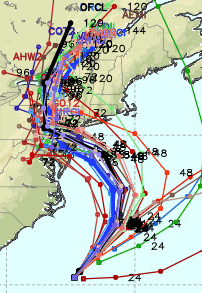The meteorological community occasionally wrings its hands at “our failure to speak with one voice.”
It would really be interesting to hear your (likely differing) voices on this topic! In hopes of stimulating such a discussion, here’s a perspective to focus minds, or (should you prefer a grittier metaphor) to serve as a target. Please join the discussion/post a comment.
Concerns about reaching consensus are as old as meteorology itself, but have mounted as the topic of conversation has turned from meteorology per se to related issues of weather impacts on society, the contributions of science to policy, and the national policy for science (including but by no means limited to federal R&D budgets). Talk of a need for consensus has grown particularly poignant since the release of the NAS/NRC Fair Weather Report of 2003. The report, a singular milestone for our community, suggested, inter alia:
“Recommendation 3. The NWS and relevant academic, state, and private organizations should seek a neutral host, such as the American Meteorological Society, to provide a periodic dedicated venue for the weather enterprise as a whole to discuss issues related to the public-private partnership.”
Meteorologists and the AMS have taken that particular recommendation to heart. Just one example, but a singular one: ever since then, they’ve held an annual Summer Community Meeting . [A brief infomercial: This year’s meeting is scheduled for State College, Pennsylvania August 11-13. Every topic is on the table, and it’s not too late for you join in! Just click on the link to check out the agenda, register, and then you too can play a part.] The meetings have been valuable, and increasingly so over the years. Today they’re just the tip of the iceberg of a growing web of communication and collaboration that now goes on between meetings. The joint is jumping.
Note that the NAS/NRC stopped short of recommending that the meteorological community speak with a single voice. Even back then, they recognized the community was probably too diverse for that… that what we needed most was opportunity and means to discuss our differences internally. Community members hold divergent views on climate change; on risk communication; on journal purviews; on big-versus-small meetings and conferences; on whether the government should buy observing hardware or purchase data streams. We can find reason to hold spirited exchanges on virtually any topic.
That said, on many occasions and with respect to a number of subjects, it’s valuable and important to be able have a process for closing ranks (or conclude that such closure is either unnecessary or unattainable). This may be particularly true when we’re not dialoging among ourselves, but rather with the larger public. Consider questions such as the following: why are forecasts sometimes different from provider to provider? What are our priorities for observations? For research? For services? How can we foster public safety in the face of weather hazards? What do we need from STEM education? What do we know about geoengineering? When discussing these matters with close colleagues, it’s well and good to be exploratory, to surface conjecture, to identify and debate views, etc. As the discussion expands to take in a wider range of publics, those newcomers to the conversation may find these distinctions confusing or off-putting.
So the question is, how controlled should our message be? Where should it lie on a scale with the Tower of Babel (as depicted here by Pieter Breugel the Elder):
at one extreme
and a foghorn monotone at the other?
Here are two examples – one from the world of meteorology, and one from the world of music – that might stimulate thought:
Spaghetti charts. (LOTRW has blogged on this before). Weather forecasters construct such spaghetti charts or diagrams (aptly named) by juxtaposing different numerical forecasts… in this instance, for the track of hurricane Sandy back in October of 2012.
The ensemble of such tracks may be derived from a single numerical weather prediction model by introducing a small bit of noise into the initial conditions or by compiling results from independent numerical models. The charts either look well-defined or present a hodge-podge depending upon the sensitivity of the forecast to the initial conditions or model assumptions. In the current figure, it’s easy to see a consensus that Sandy would turn inland somewhere around New Jersey, but several runs showed the hurricane moving instead out to sea.
By analogy, when people ask different members of our community about specific issues or topics, and encounter a range of responses, they can surmise there’s considerable uncertainty or difference of opinion. If instead they find the responses to be relatively similar, that suggests community consensus. Responses that are generally similar with the exception of a clear outlier or two don’t destroy the notion of consensus so much as they make a statement or offer insights about the people or institutions proffering the wildly different views. This picture suggests that our community might reasonably be relaxed when individual members exercising considerable variation in their views on just about any topic.
Harmony. Imagine trying to perform Handel’s Messiah in a single voice. Which would you choose? The bass part? Tenor? Alto? Soprano? The result would be the palest shadow of a magnificent piece of music. What matters as much as any single voice is the harmony of the whole – how it all fits together. When meteorologists offer diverse positions on any topic, but it’s evident to the hearers that the community is in general accord, or singing from the same score (substitute your own choice of metaphor here), then it’s easy and natural to grasp both the core essentials of the message and the nuance.
In conclusion, then, perhaps we ought to see communication – even communication of risk in the face of hazards, where the historic emphasis has been placed on strict discipline – as ensembles (spaghetti charts), or harmony-laced musical scores, rather than narrowly monotonic messages. By the way, with today’s ubiquitous social networking most publics are more accustomed to and comfortable with getting their messages in this mode. They/we live and function in an information soup… and it’s a wonderfully thick and nutritious information soup… versus the thin (information) gruel my generation was raised on.
The key ingredient to the information soup, the secret sauce, is harmony. When others hear our separate messages and experience harmony, they can accommodate a range of views. They’ll linger. They’ll pitch in. But if they look at our community and find discord, invective, backbiting, or condemnation, then they’ll look for an excuse to walk (or run) away.
Going back to that music analogy, jazz might be an even better example than classical music. Musicians have little more than a card reminding them they’re playing A Train, not Basin Street Blues. No two performances are ever the same. And if jazz is too complicated, let’s go back to something you likely remember from childhood, and I remember from parenting young children: Sesame Street’s High, Middle, Low.
Worth a listen… and like most Sesame Street wisdom, worth taking to heart, whether child or grownup. You might give it two minutes, let it take you back… 🙂
_______________
[Note: I hope – but sadly can’t promise! – to explore this topic further in subsequent posts. Next up would be a look at an example where the AMS does speak with one voice now: our statements.]



